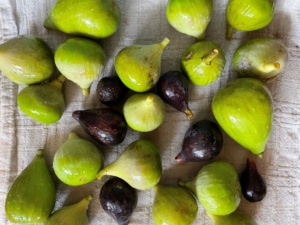Figs from my garden.FIGS love Garden Pearls too! By Gudrun Mahrt
Figs – Are they hard to grow? Not at all – if you live in zone 6 or warmer. Don’t be afraid to try this dependable little tree. You will enjoy its fast growth, beautiful canopy plus a delicious reward of nutritious, sweet fruit. Make your neighbors jealous. The most cold-hardy and sweetest fig variety I grow in our zone 6 is “Desert King”.
In areas with single digit temperatures during winter, fig trees may die back to the ground but if well protected with a thick layer of organic matter, figs sprout right back and can bear fruit on the new vigorous growth. Although a subtropical species, there are over 100 varieties of figs that are fully cold hardy to 10 degrees F during dormancy. For sweetest fruit, they require hot, dry summers and wet, cool winters. Grow your tree in a sheltered South or West corner, close to a structure or wall, they even do well in containers. You can’t find a fruit tree that is less demanding and easier to grow.
Have I convinced you that this little, reliable tree is worth a spot in your garden? I’d love to share with you some of my fig growing tips.
Planting
Choose parthenocarpic or seedless figs. Unlike most figs, parthenocarpoic figs can grow fruit without a natural wasp pollinator that only live in frost-free regions. Good parthenocarpoic varieties are Desert King, Lattarula Honey Fig, and Brown Turkey. Honestly, there are countless varieties but these three are commonly available. If these are unavailable, there are several varieties that are similar in growth habit and fruit taste.
- Figs prefer full sunlight, at least 8 hours per day
- USDA Zone 6 to 11
- Well drained or compost enriched soil required
- Alkaline soil is preferred, between pH 6 and 8, Figs do NOT tolerate acid soils
- When established, very drought tolerant
- Figs don’t have tap roots but have a shallow root system, 2-3 times wider than its canopy, so don’t plant too close together.
Maintenance
- Figs like heavy applications of manure and compost in fall
- Grow well without fertilizers, or if you must, you can use 1 cup of slow release around the tree
- Sprinkle 5 lbs. Garden Pearls® – Lime around the base every spring
- Water young or stressed mature trees a few times during spring and summer
- Stop watering July/August to encourage fruit ripening and prepare for winter
- Easily pruned, but can reach 15 to 30 feet and just as wide if allowed
- Prune up to 1/3 of branches after harvest or in winter
- Use the 4 D pruning system to take out: Dead, Diseases, Damaged branches and then focus on overall tree Design
- Because fruit will only grow on the new wood of the branches’ tips, prune only 1/3 of the full-length stems, do not cut off every branch tip.
Bonus – How to make a good growing medium for planting and propagating figs
Fill one wheelbarrow with:
- 2/3 commercial potting soil or growing medium (without fertilizer)
- 1/3 of your local garden soil
- 1 cup of organic based fertilizer for slow release
- 6 to 10 lbs. of Garden Pearls® Lime
Mix well. If you have heavy soil you can exchange some of the potting soil with perlite for good aeration. Fill this into your planting hole or use it in containers. Yes, this mix also works for fig tree cuttings.
Best time for taking fig tree cuttings is during dormancy in late fall and winter. You can store the cut branches for propagation in a burlap bag in the refrigerator or plant them horizontally into the ground with moist sand or sawdust. Fig branches root quite well, but a rooting hormone added at planting time in early spring when placing into pots helps to build roots faster. Keep moist and warm and plant out into the permanent spot after sufficient roots have formed and new leaves start growing.
Fruit
Fresh figs are delicious, taste sweet, but bruise easily. They must be picked fresh from the tree when ripe. High in calcium, potassium, and magnesium figs are a good source of mineral nutrition to humans (and birds, by the way). Mineral content is determined by fig trees supply in the soil. Adding pelletized Garden Pearls Lime not only provides important calcium to your fig tree, it benefits the nutritious, sweet fruit. Did you know that this powerhouse of a fruit contains 3.2 times more calcium than other fruit?
Figs are rich in anti-oxidants, very high in soluble fiber, and contain enzymes that aid in digestion. With a natural humectant in the fruit, this substance helps keep baked products moist and fresh. Think Fig Newtons!
And remember…fig trees love Garden Pearls Lime!
References: Gudrun Mahrt’s garden in Zone 6 SW Washington,
https://www.permaculturenews.org/2016/09/30/dig-fig-essential-guide-need-know-figs-ficus-carica/
http://figs4fun.com/More_Info_Paradise_Nursery.pdf
For great recipes and fig folklore, I recommend Sherri Lee’s book: “Under the Fig Leaf“.




